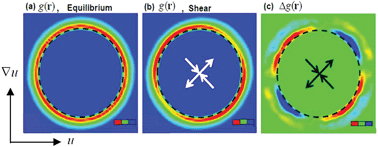Flow instability due to coupling of shear-gradients with concentration: non-uniform flow of (hard-sphere) glasses†
Abstract
Flow-induced instabilities that lead to non-uniform stationary flow profiles have been observed in many different soft-matter systems. Two types of instabilities that lead to banded stationary states have been identified, which are commonly referred to as gradient- and vorticity-banding. The molecular origin of these instabilities is reasonably well understood. A third type of instability that has been proposed phenomenologically [Europhys. Lett., 1986, 2, 129 and Phys. Rev. E, 1995, 52, 4009] is largely unexplored. Essential to this “Shear-gradient Concentration Coupling” (SCC-) instability is a mass flux that is induced by spatial gradients of the shear rate. A possible reason that this instability has essentially been ignored is that the molecular origin of the postulated mass flux is not clear, and no explicit expressions for the shear-rate and concentration dependence of the corresponding transport coefficient exist. It is therefore not yet known what types of flow velocity- and concentration-profiles this instability gives rise to. In this paper, an expression for the transport coefficient corresponding to the shear-gradient induced mass flux is derived in terms of the shear-rate dependent pair-correlation function, and Brownian dynamics simulations for hard-spheres are presented that specify the shear-rate and concentration dependence of the pair-correlation function. This allows to explicitly formulate the coupled advection–diffusion equation and an equation of motion for the suspension flow velocity. The inclusion of a non-local contribution to the stress turns out to be essential to describe the SCC-banding transition. The coupled equations of motion are solved numerically, and flow- and concentration-profiles are discussed. It is shown that the SCC-instability occurs within the glass state at sufficiently small shear rates, leading to a banded flow-profile where one of the bands is non-flowing.


 Please wait while we load your content...
Please wait while we load your content...